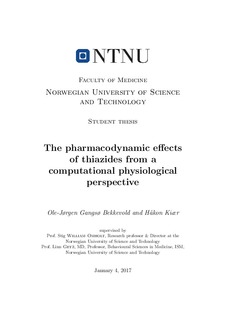| dc.description.abstract | Background. Primary hypertension is the leading risk factor for mortality in low-, middle- and high-income countries and affects more than one billion people world-wide. Multi-scale and multi-organ computational models seeking to explain the emergence and maintenance of primary hypertension at the individual level are now emerging, but in order to be used in personalized hypertension therapy these models have to be able to describe the dynamic effects of drug administration.
Objective. To provide an overview of the thiazides’ hemodynamic effects in humans, with a particular focus on compiling and assessing information instrumental for constructing physiological computational models capable of describing the effects of this drug class in individuals.
Method. We did a systematic literature search in the PubMed data-base on hemodynamic effects of thiazides and loop- diuretics in monotherapy. The loop diuretics were included for comparison. After the systematic literature search, we extracted the quantitative data and did a meta-analysis of the hemodynamic and hormonal effects of thiazides and loop diuretics. Our meta-analysis findings were then compared with those of high impact papers in the field. Based on the data from the meta-analysis we sought to describe the causal mechanisms underlying the thiazides’ effects on the vascular system in order to ease the mathematization of our findings.
Result. The thiazides have an immediate diuretic effect, followed by a decline in plasma volume. The body partially compensates for this fluid loss by activating the renin angiotensin aldosterone system (RAAS). A new steady state is established. However, after four to six weeks plasma volume and cardiac output paradoxically return towards pretreatment levels while the total peripheral resistance (TPR) decreases. Blood pressure remains lowered. The cause of this shift is unclear. The two main hypotheses seeking to explain this shift are named the direct vasodilation hypothesis and the reverse autoregulation hypothesis. In addition to providing the basic scaffold for modelling the effects of thiazides, we suggest how these two competing hypotheses might be tested in a computational physiology setting.
Conclusion. The meta-analysis shows that there is a dramatic variability in how individuals respond to thiazides. This variability appears to be poorly understood, in particular how the thiazides effect the TPR. Considering the therapeutic prominence of this drug class, this is somewhat surprising, and it suggests that we have a long way to go before we are in position to individualize the administration of thiazides and other anti-hypertensive drugs. And due to the complexities involved, it is hard to see how such individualization can be achieved without extensive use of computational models capable of accounting for the physiological variability of humans. | nb_NO |
